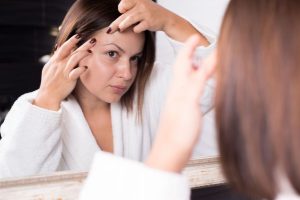SKIN PICKING DISORDER THERAPY IN TORONTO
What is Skin Picking Disorder?
Many people pick their skin from time to time. Occasional picking at cuticles, acne, calluses or other skin irregularities is very common. Skin picking is not considered a disorder unless it is frequent enough to cause significant distress or difficulties with one’s life. Skin Picking Disorder, also known as excoriation disorder, refers to recurrent picking, squeezing, or digging in to the skin often in an effort to improve imperfections but often resulting in scarring or significant damage to skin tissue. Recurrent skin picking can also cause significant distress and interfere with daily activities. Those who struggle with skin picking often make efforts to conceal or hide the damaged skin and may spend lots of time camouflaging the affected areas. Skin Picking Disorder may hurt someone physically, emotionally and socially as it can interfere with one’s social life, school and work.

Any area of skin on the body may be targeted usually with fingers and fingernails and sometimes with sharp objects such as tweezers, scissors or pins. Someone may spend hours each day picking their skin in a manner that feels irresistible. Skin picking sites span across the body and may change over time. Individuals often pick from more than one area of their body targeting healthy or already damaged skin. The function of the behaviour is not to cause harm to oneself but rather as a way to self-regulate or self-soothe. Skin picking disorder is a type of Body-Focused Repetitive Behaviour. It is often misunderstood yet these behavioural struggles are commonly reported habits that people want to change. Skin picking may affect approximately 3 to 6 percent of the general population or 1 in 20 people. Skin picking can begin in childhood or adulthood. It often begins in early adolescence around age 14 to 15 and tends to be seen more commonly in women than in men. Generally it tends to be chronic with it’s intensity fluctuating over time.
Skin picking episodes can give someone immediate relief from unwanted sensations because it can act as a distraction and because it may feel satisfying. However the immediate relief is often followed by making someone feel worse because of the physical symptoms of itching, infection, pain, bleeding, scarring or skin discoloration which follow and feelings of anxiety, sadness, anger, shame, embarrassment, guilt or overall sense of low self-worth. If there is shame or embarrassment people may conceal the areas with clothing or camouflage with makeup and avoid certain social activities which can lead to isolation and reduced productivity. The problem can grow stronger and become more challenging to overcome with time.
Why do people pick their skin?
The exact causes of skin picking disorder are unknown. It seems to occur more in families. Biological, genetic and environmental factors play a role in its development making people more vulnerable to these sorts of problems. People pick their skin for various reasons. People may pick out of boredom and may not even be aware of their picking. People may pick to try to cope with negative emotions.
Which behavioural therapy methods may be used for Skin Picking Disorder?
Research into treatment for skin picking disorder has grown over the past decade. Numerous research studies demonstrate their effectiveness. Although no particular treatment has been found to be effective for everyone a number of evidence-based treatment options show promise for many people. Behavioural therapies are among the most evidence-based treatments in the field of Body-Focused Repetitive Behaviours. Psychological interventions that have demonstrated promise for the effective treatment of Body-Focused Repetitive Behaviours include Habit Reversal Training (HRT) which has been around since the 1970s, Comprehensive Behavioural Treatment (ComB), Acceptance and Commitment Therapy (ACT), Dialectical Behavior Therapy and most recently Integrative Behavioral Therapy (IBT). Comprehensive Behavioural Treatment (ComB) is a flexible cognitive behavioural approach based on the triggers that cue and maintain the skin picking behaviour. Acceptance and Commitment Therapy (ACT) focusses on mindful awareness and changing the relationship someone has with their inner experiences and lessening the impact it has on one’s life without the struggle. This approach promotes an increased acceptance of and tolerance for urges to pick or pull without acting on them. When one understands and experiences their urges without responding to them it can be quite liberating.
At Cognitive Behaviour Therapy Toronto I combine all of these treatment methods to assist my clients with their skin picking issues in an individually tailored plan that incorporates cognitive behavioural strategies. Family involvement in treatment may be included to assist family members in learning how to best support their loved one. Treatment for your body-focused repetitive behaviour can give you, as it has for others, the tools to change your behaviour patterns and modify your thoughts and feelings that have fueled your skin picking. Your unique sensory sensations, ideas, thoughts, beliefs, emotions, motor and environmental needs will be met in other healthier and adaptive ways. Treatment is a healing process that may seem challenging but with patience and with perseverance healing is possible for the majority of individuals.
There is so much more to you than your skin complexion. It does not define who you are or what you value in life. We might wish that skin-picking issues would go away on their own. However support is available when the time is right for you!
BackMemberships & Accreditations
FAQ
View AllWhat are the benefits of Cognitive Behaviour Therapy?
There are so many benefits that Cognitive Behaviour Therapy has to offer. read more
Why should I choose Cognitive Behaviour Therapy?
CBT therapy is appropriate when you have a specific behaviour that you would like to change or a goal you wish to change. read more










